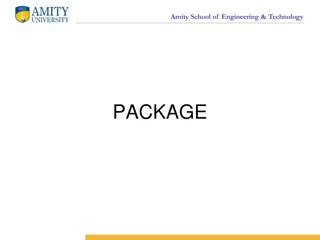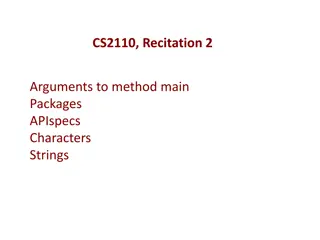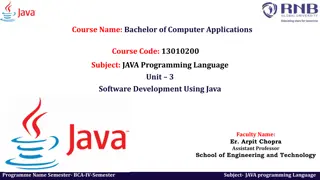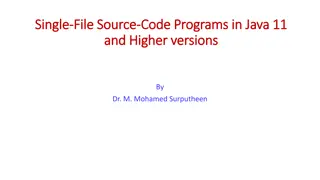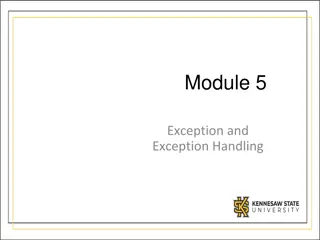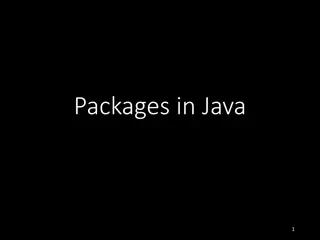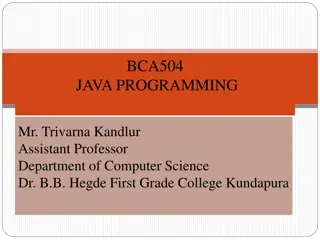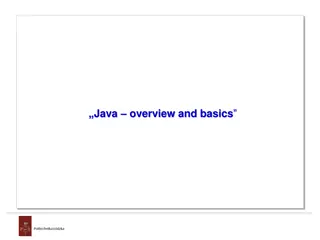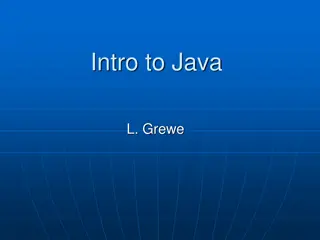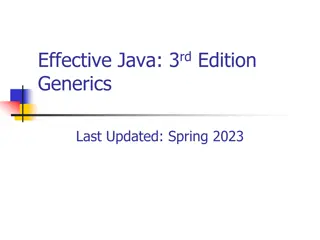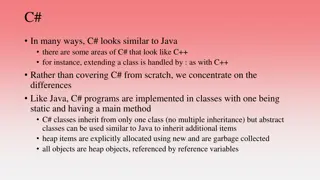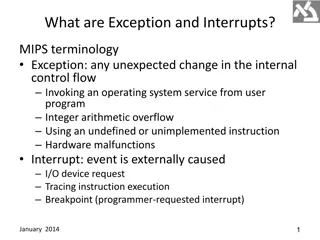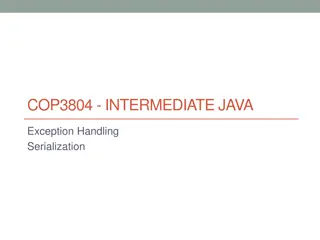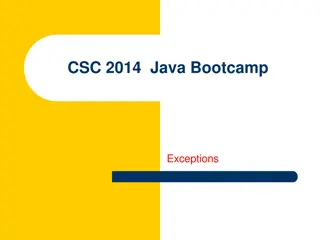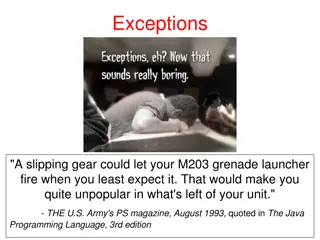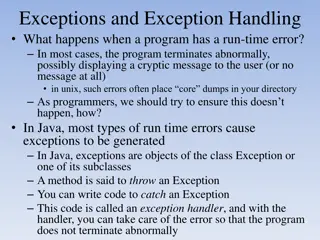Java Exception Handling Basics
In this lesson, we delve into the essentials of exception handling in Java, including catching exceptions, finally blocks, and utilizing the throws keyword. Learn how to handle NumberFormatException when converting strings to integers, avoid using System.exit(), and create custom exceptions for specific error scenarios. Understand the significance of proper exception handling in Java programming.
Download Presentation

Please find below an Image/Link to download the presentation.
The content on the website is provided AS IS for your information and personal use only. It may not be sold, licensed, or shared on other websites without obtaining consent from the author.If you encounter any issues during the download, it is possible that the publisher has removed the file from their server.
You are allowed to download the files provided on this website for personal or commercial use, subject to the condition that they are used lawfully. All files are the property of their respective owners.
The content on the website is provided AS IS for your information and personal use only. It may not be sold, licensed, or shared on other websites without obtaining consent from the author.
E N D
Presentation Transcript
What did we talk about last time? Exceptions Catching exceptions finally blocks The throws keyword
Sometimes you need to convert a String to an int (or double) But you don't always know that the String is a properly formatted representation of an int String number = "eggplant"; // Not a number! int value = Integer.parseInt(number); // Fails! In these situations, it can be useful to catch a NumberFormatException and ask for another String
int value = 0; boolean success = false; while(!success) { try { System.out.print("Enter a number: "); String number = in.next(); value = Integer.parseInt(number); success = true; } catch(NumberFormatException e) {} // Don't need to do anything } How do we know parseInt() can throw a NumberFormatException? Read the Java API!
System.exit() is a method that will shut down the entire JVM if(trouble) { System.exit(-1); // Exits with error code -1 System.out.println("You will never reach this line."); } It's roughly equivalent to the exit() function in C You should never use System.exit() Exception handling is a much better way to end a program System.exit() doesn't give a chance for other threads to clean themselves up
If you're creating a framework of code, you might want to create your own exceptions For the Uno game, I created: IllegalCardException IllegalDrawException EmptyDeckException You shouldn't create exceptions often, but they're useful if you want to name a particular program error
Exceptions are classes like any other in Java They can have members, methods, and constructors All you need to do is make a class that extends Exception, the base class for all exceptions public class SimpleException extends Exception { } That's it. Although it makes them long, it's good style to put the word Exception at the end of any exception class name
In some cases, you might want a constructor that lets you explain why the exception was created public class TooManyEyeballsException extends Exception { private final int eyeballs; public TooManyEyeballsException(int eyeballs) { this.eyeballs = eyeballs; } public int getEyeballs() { return eyeballs; } }
When you catch an exception, you get a reference to the exception object itself It's customary (but not required) to call this reference e try { if(eyeballs > 2) throw new TooManyEyeballsException(eyeballs); } catch(TooManyEyeballsException e) { System.out.println("Ugh! " + e.getEyeballs() + " is too many eyeballs!"); }
All Exception objects have a String message inside of them If you want your custom exception to have a message, you have to call the Exception constructor that takes a String public class DoomException extends Exception { public DoomException(String prophecy) { super(prophecy); // Uses prophecy for message } }
The throw keyword is used to start the exception handling process You simply type throw and then the exception object that you want to throw Most of the time, you'll create a new exception object on the spot Why would you have one lying around? throw new CardiacArrestException(); Don't confuse it with the throws keyword!
Code you write will seldom throw exceptions explicitly Remember than an exception is thrown when something has gone wrong Most of the time, your code will catch exceptions and deal with them If you write a lot of library code, you might throw exceptions to signal problems If you throw a checked exception in your method, you have to mark it with a matching throws descriptor
Here's a method that finds the integer square root of an integer public static int squareRoot(int value) { if(value < 0) throw new IllegalArgumentException("Negative value!"); int root = 0; while(root*root <= value) { ++root; } return root - 1; } If value is negative, an IllegalArgumentException will be thrown
One way that exceptions interact with inheritance is that all exceptions inherit from Exception Remember that you can use a child class anywhere you can use a parent class A catch block for a parent will catch a child exception If NuclearExplosionException is a child of ExplosionException, an ExplosionException catch block will catch NuclearExplosionException
Because a parent catch will catch a child, you have to organize multiple catch blocks from most specific to most general: try { dangerousMethod(); } catch(FusionNuclearExplosionException e) { System.out.println("Fusion!"); } catch(NuclearExplosionException e) { System.out.println("Nuclear!"); } catch(ExplosionException e) { System.out.println("Explosion!"); } catch(Exception e) { // Don't do this! System.out.println("Some arbitrary exception!"); }
Always make exceptions as specific as possible so that you don't catch exceptions you didn't mean to Always put code in your exception handlers so that something happens Otherwise, code will fail silently Never make a catch block for Exception That will catch everything!
In COMP 1600, we said that you can only override a parent method if you write a method that has the same name, takes the same parameters, and returns the same type That was a lie. You can change the parameters and the return type slightly, if you follow certain rules
Hoare's consequence rule says that a method can override a parent method as long as: 1. Its parameters are broader (or the same) 2. Its return value is narrower (or the same) In other words, it will take even more kinds of input but will give back fewer kinds of output
public class SandwichShop { public Sandwich getSandwich(Dollars dollars) { return new Sandwich(dollars); } } Narrower Broader public class SubarmineSandwichShop extends SandwichShop { @Override public SubmarineSandwich getSandwich(Money money) { return new SubmarineSandwich(money); } }
Hoare's consequence rule applies to the exceptions that a method can throw as well If a method overrides a parent method, it can only throw exceptions that are the same or subtypes of the exceptions that the parent method throws Otherwise, someone might call the method on a child object and get exceptions they didn't expect
public class Vehicle { public Trip ride(String destination) throws CrashException, NauseaException { return new Trip(destination); } } Narrower public class Helicopter extends Vehicle { @Override public HelicopterTrip ride(String destination) throws HelicopterCrashException { return new HelicopterTrip(destination); } }
Review Look over chapters 1 6, 8 12, and 17
Finish Project 1 Due Friday! Exam 1 is Monday



